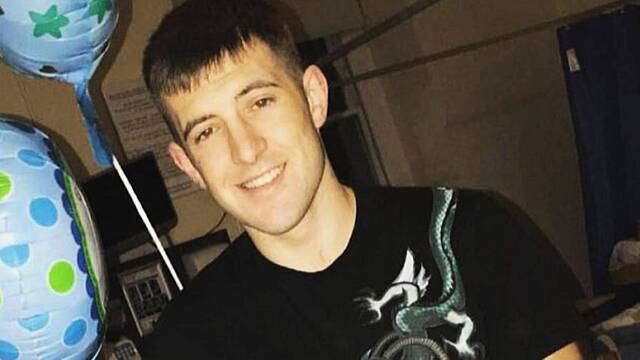Updated: 6.30pm
A Dublin man has been found guilty of murdering a father of one by shooting him three times while the victim pushed his four-month-old son in a pram in broad daylight.
The jury of seven men and four women took just over three hours to find that Wayne Cooney was the cyclist who circled Jordan Davis for three days like a "shark moving towards its prey" before firing eight shots at him from a 9mm pistol.
Mr Davis suffered three gunshot wounds, including one to the head that killed him instantly. A child who happened to be cycling through the lane was just a few feet away when Cooney opened fire.
The State told the jury that Mr Davis was a drug dealer, but added that this did not reduce his entitlement for respect to his right to life.
Following the jury verdict, Mr Justice Tony Hunt remanded Cooney (31) in custody ahead of a hearing next Friday morning, in which members of the victim's family will be invited to speak before Cooney is jailed for life.
Mr Justice Hunt thanked the jurors for their hard work in a "distressing" trial, describing the recklessness of Cooney in firing eight times while Mr Davis pushed his son in a pram as "astonishing".
Mr Davis' mother Sandra Davis, who gave evidence during the trial, was supported by friends and family as the verdict was read out.
Drug debt
The prosecution alleged that Mr Davis owed €70,000 to a local drug dealer, identified only as CD in the trial, who was the brother of Cooney's then-girlfriend.
When Mr Davis's mobile phone was examined by gardaí, they found a message from CD warning Mr Davis: "I'm on your case mate, it won't be long," and later telling him: "Soon, very soon, bang bang."
Prosecution barrister Bernard Condon SC told the jury that the circumstantial evidence against Cooney was such that he was either the shooter or the "most unlucky person ever".
A garda had identified Cooney from CCTV footage as the cyclist circling Mr Davis. Cooney's DNA was also found on a glove in an area on Belcamp Lane where the shooter could be seen discarding gloves and a black body warmer minutes after the shooting.
Cooney was also identified returning to the same area to retrieve the body warmer about one hour and 20 minutes after the shooting.
The prosecution also relied on mobile phone evidence which showed Cooney's phone was calling CD at moments when the person identified on CCTV as the shooter could be seen holding a phone to his ear.
This was the first trial in which the use of mobile phone evidence was contested following a ruling by the Court of Justice of the European Union which found that Ireland's system of retaining and accessing mobile phone data was a breach of privacy rights.
Mr Justice Hunt allowed the mobile phone evidence, saying that the "weighty public interest and common good associated with the need to properly investigate this murder comprehensively outweighed any limited privacy rights attaching to the data".
Contested evidence
Following the jury's verdict, Mr Justice Hunt told the jury that there had been hearings before the trial in which the defence had tried to exclude relevant evidence relating to CCTV, mobile phones and certain witnesses, including Stacey Hayes.
After the murder, the shooter's movements were tracked by CCTV as he walked to a nearby bus stop. Ms Hayes told the trial that at the same time she was driving around Darndale with Cooney's girlfriend, identified only as EF.
EF was speaking to someone on the phone and directed Ms Hayes until they came to the same bus stop where EF said, "there's the idiot" and told Ms Hayes to pull in.
Ms Hayes said she recognised the person who got into her car as EF's boyfriend, Cooney. She denied to Cooney's defence barrister, Giollaiosa O Lideadha SC, that criminals had put pressure on her to make a false allegation against Cooney.
Mobile phone evidence showed Cooney's phone was on a call to EF's phone for 200 seconds at the exact time Ms Hayes said EF was directing her to the bus stop while speaking to someone on the phone.
Cooney denied to gardaí that he was the person on the bicycle, or that he was the shooter.
Mr O Lideadha told the jury that the prosecution case contained "large holes" and did not amount to proof beyond reasonable doubt.
He said there could have been a number of people who had a motive to murder Mr Davis, and also questioned the credibility of the garda who identified Cooney from CCTV footage.
He further questioned the prosecution's claim they had proven that the mobile phone belonged to Cooney.
The jury's verdict is likely to be appealed. During legal argument, Mr O Lideadha described the judge's charge to the jury as "the complete negation of a fair trial".
He indicated that if the case goes to the appeal court he will make submissions regarding the judge's presentation to the jury.
Drugs
Mr Davis's mother told the trial she knew her son was dealing drugs when he started buying expensive clothes and going to Amsterdam.
He spent over €1,000 on a buggy when his son was born, Ms Davis said, adding that things started to "go downhill" after January 2019 when her son's "so-called friends" all disappeared.
In March that year, Ms Davis said five men appeared in her garden. One of them shouted at her: "Tell Jordan to pay his f*cking bills, it's not over, tell Jordan we'll be back."
That night the windows of the house were smashed, she added.
By May 2019, Ms Davis said her son "seemed to believe that things were okay" and he began to relax.
"He sorted it out, he said he sorted it out," she said.
She agreed that Mr Davis had been friends with Sean Little, who was shot dead one day before her son.
During a separate investigation into CD, gardaí discovered a drug dealer's "tick list", which contained names of people who owed money to CD.
Gardaí identified a person owing €70,000 and marked as "Jordo" as being Jordan Davis.
Jury charge
In a lengthy charge to the jury, Mr Justice Hunt said that if they were satisfied beyond a reasonable doubt that Cooney was the cyclist who came up behind Mr Davis and shot him, they must find him guilty of murder.
He told them that the gunman who cycled up behind Mr Davis and shot him dead was "undoubtedly guilty of murder" but the issue for them to resolve was whether the cyclist was Wayne Cooney.
Mr Justice Hunt told the jury that if the prosecution failed to prove beyond a reasonable doubt that Cooney murdered Mr Davis, they could find that he impeded the arrest or prosecution of the murderer by taking away the body warmer.
He said that, by his own admission, Cooney was seen on CCTV at Belcamp Lane about one hour and 20 minutes after the murder.
He said the shooter disposed of the body warmer during a 40-second period when he was off-camera and when Cooney retrieves the body warmer, he also went off-camera for almost exactly 40 seconds.
He said the jury should consider that if Cooney was not the person who left the body warmer, he must have acquired some knowledge that it had been put there.
He added: "If he didn't do the shooting, he acquired the knowledge of where the item was in that hour and 20 minutes. That has to be considered by you."

On this view, Mr Justice Hunt said, Cooney was not the shooter but might have been "covering up". He further told the jury: "If he didn't do the shooting, he didn't get to the laneway by accident.
"There had to be some information that brought him there, he had to know something about what he was retrieving and where he was retrieving it from," the judge added.
Cooney, with an address at Glenshane Drive in Tallaght, had pleaded not guilty to the murder of Jordan Davis (22) at a laneway beside Our Lady of Immaculate National School in Darndale, Dublin on May 22nd, 2019.
He also pleaded not guilty to possessing a 9mm semi-automatic pistol and to possessing ammunition in circumstances that give rise to the reasonable inference that he did not have them for lawful purposes. The jury convicted him on those counts also.







